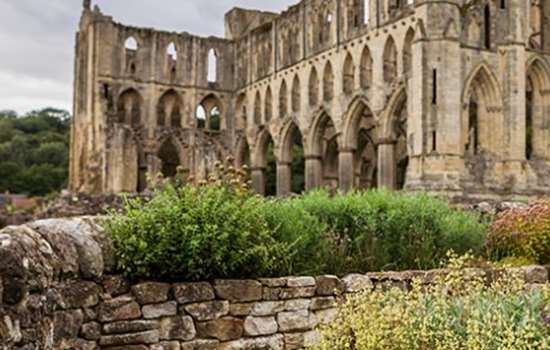
Being a monk is a commitment for life – and during the medieval period it certainly wasn’t an easy calling.
As all monks took vows of poverty, chastity, obedience and stability (for example, not to leave the cloister), this naturally impacted their daily lives. But a lesser known fact is how much attention monks paid to their gardens, where they would sometimes spend up to five hours a day.
We take a closer look at the history of Mount Grace Priory and the role gardens played in the daily life of its monks.
What was it like to be a monk in the medieval period?
Medieval monks devoted their lives to a calling which was fundamental to their role and life. This involved serving God, but in addition, many lived in a secure retreat with like-minded people. Perhaps this was also to escape from what was a violent world, and as a consequence they lead a quiet, ordered and peaceful life dedicated to religious service.
The major orders of medieval monks including Carthusians, Benedictines (such as Cluniacs) and Cistercians all had differing ways of life and worship. This dictated the shape of their days including their gardening duties.
Different orders of monks did different things with their sites and gardens, for example the Carthusian order at Mount Grace Priory had individual cells where they gardened, whereas the Cluniac order of monks at Castle Acre would have expressed their love of decoration in their communal gardening.
Sites with ‘monk’s gardens’ today are rare. English Heritage has three sites (Mount Grace Priory, Rievaulx Abbey and Castle Acre Priory) with herb gardens representing plants which the monks would have used. However, only at Mount Grace Priory do we see the remains of a cell and its garden. Here the monks were in a separate cell with a garden where they lived their life in solitary silence venturing forth to pray. Food was introduced via a hatch by a lay brother who tended to the monks.
Mount Grace Priory today © Historic England Photo Library
Carthusian monks and ‘Gardens of Eden’ at Mount Grace Priory
The garden of the Mount Grace Priory cell is English Heritage’s best preserved example of monastic horticulture. It was replanted for the first time in 1994, following archaeological excavation of the cells. The excavations showed that the lay-out and use of each garden varied according to the inclination and interest of the individual monk.
The pattern of paths and beds in the garden was based on archaeological evidence, but it was uncertain which plants were used or how they may have been arranged in the beds. None of the recent planting was intended to be a restoration or reconstruction of the original garden. It instead was a demonstration of the kinds of plants that were grown in gardens at the time the monastery flourished.
Equipment, too, has changed how we tend to our gardens today. Monk’s tools would have been simple wooden and metal ards (like a small hand pulled plough) or mattocks rather than the mechanised marvels of today’s horticulture. Rather than a tractor, power for larger plots would have been provided by oxen.
Cell gardens as at Mount Grace Priory provided monks with the opportunity for manual labour within the confines of their own cell, which was a key part of the Carthusian ideal. As a hortus conclusus (enclosed garden) they also had biblical associations including the garden of the ‘Song of Solomon’, and alluded to the ‘original’ Garden of Eden, or to ‘Paradise’ itself. These spaces were not primarily for food production but had multiple functions of spirituality, health and utility. The mass of food for the monks came from much larger kitchen gardens, plots and farms elsewhere.
These cell gardens were strongly geometric in form, often compartmentalised (defining spaces for medicinal or poisonous species) and in the 15th century started to become decorative. This included a mix of medicinal and aromatic herbs, and flowering plants to lift the mind and spirit and to aid contemplation.
Sage (Salvia officinalis), which is grown at Mount Grace Priory today – Photo Isaac Wedin via Flickr/Creative Commons
24 HOURS WITH A CARTHUSIAN MONK AT MOUNT GRACE PRIORY
Here we break down the typical day of a Carthusian monk to highlight the importance of their garden in daily life.
5:30 The monk would awake to the sound of a bell near their ear.
6:00 The church bell rings when the first service ‘prime’ is said, accompanied by a choir in the oratorium. This extends with prayer until 7:45.
7:45 Conventional Mass is held in church (on site). Churches in the period were lit with plants such as mullein (Verbascum thapsus) soaked in tallow. Underfoot sweet-scented bedstraw (Galium odoratum) was used to walk on when which, when dried, has a strong scent of new mown hay.
8:30 The monks would return to their cell to perform manual labour. This included tending to their gardens by watering their plants, cropping, harvesting and general maintenance.
10:00 The monks pray and fetch their dinner from the hatch: flavourings from herbs would have included rosemary (Rosmarinus officinalis), wild thyme (Thymus serpyllum), true lavender or English lavender (Lavandula angustifolia), sage (Salvia officinalis), fennel (Foeniculum vulgare), and saffron crocus (Crocus sativus). This was followed by solitary recreation, which may have involved a return to the garden.
11:30 Spiritual reading, study and more manual labour in the gardens.
14:30 Vespers (prayers) are said.
14:45 Return to church to sing Vespers.
16:00 Return to the cell for study.
16:30 Supper is eaten, often comprising eggs and salad with probably home-grown ingredients such as radish (Raphanus sativus), lettuce (Lactuca sativa), and rampion bellflower (Campanula rapunculus). This is followed by a spiritual reading and examination of conscience known as the ‘Recollection’.
17:45 A bell sounds for de Beata (musical mass)
18:30 The monk retires to bed still wearing much of his habit as his sleep is relatively short.
23:30 The monk rises and says Matins (the monastic night-time liturgy).
23:45 The monk leaves his cell to go to sing Matins which is largely sung lit by lamps.
2:45 Return to the cell to finish the ‘day’ with Prime de Beata; (a prayer) and to sleep; he will rise again in three hours.
Reconstruction drawing of lay brother bringing food to a monk’s cell by Ivan Lapper © Historic England Photo Library
Gardens for crops or contemplation?
It would be fair to say that today’s horticulturalists are much more concerned about either the decorative qualities of horticulture, or the production of an allotment, than the medieval monks were. Monks would have been concerned far more about the contemplative, and spiritual qualities of the garden which they would have related to a biblical paradise. Gardens and plants for them would have been full of spiritual symbolism that has been largely lost to the modern gardener.
In addition monks would have grown plants for medicinal reasons and were in fact at the forefront of plant pharmaceutical practice.
From the daily lives of medieval monks we can see that attention to gardens was of importance. Gardening was part of the daily ritual and was valuable to both recreation and spirituality.
Visit Mount Grace Priory to experience the sights and smells of a monastic garden. Today you can see several varieties of herbs like thyme and mint and fruit bushes such as plum tree and grape vines. Mount Grace Priory is open daily from 10am to 6pm.
For more gardening inspiration, visit our Historic Gardens page.


